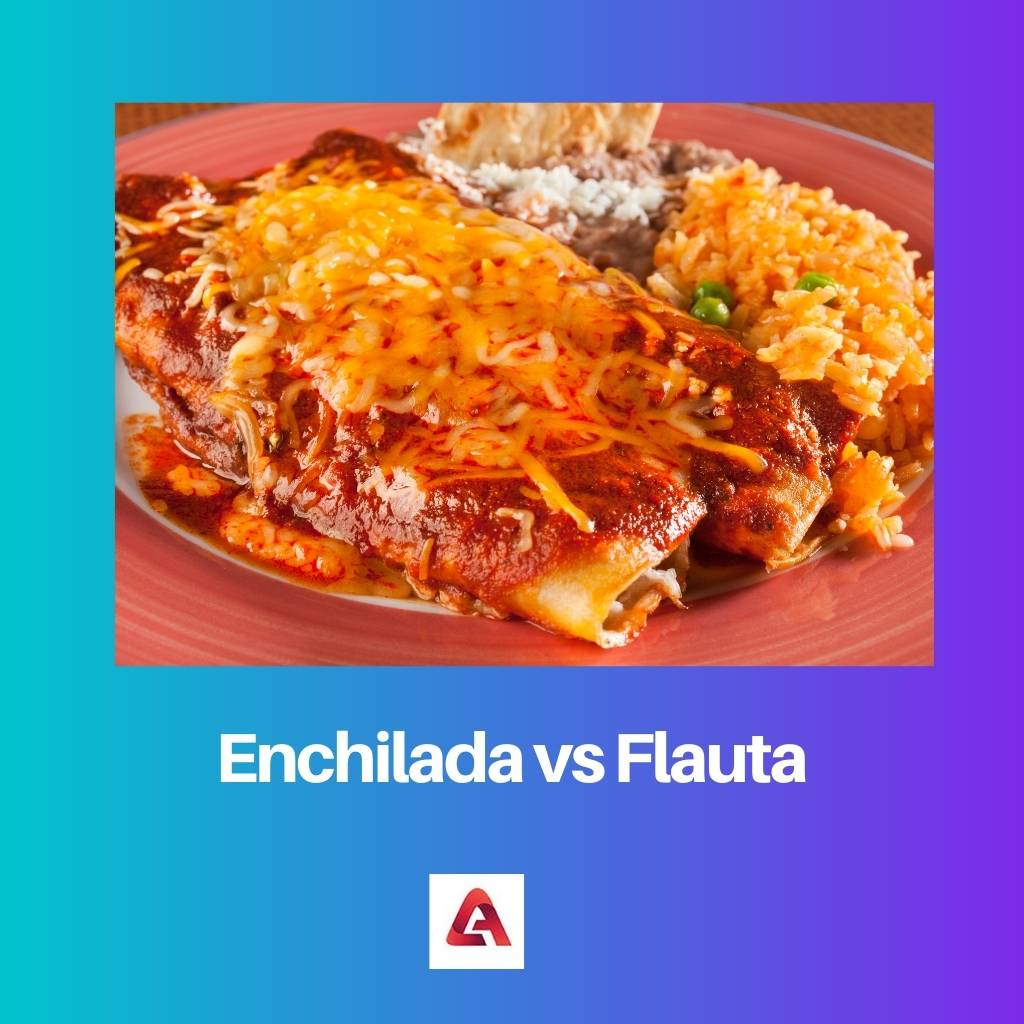Cooking around the world has some excellent cuisine. The Flautas fried palm-stuffed sandwiches make the guy sparkle to taste. The savoury foods create a fantastic mix with a delicious taste.
Two of the world’s most prominent culinary products, Enchilada and Flauta, have become exclusively prominent due to their taste.
Apart from their origin, there are several variations between them. Cooking around the world has some excellent cuisine. The Flautas fried palm-stuffed sandwiches make the guy sparkle to taste. The savoury foods create a fantastic mix with a delicious taste.
In this world, several plates have crossed times. Two of the world’s most prominent culinary products, Enchilada and Flauta, have become exclusively prominent due to their taste. Enchilada and Flauta are Mexican meals with Spanish names among these food wrappers, which many have liked.
Key Takeaways
- Enchilada is a Mexican dish consisting of a tortilla filled with meat, beans, or cheese, covered with chilli sauce, and baked. At the same time, Flauta is a Mexican food made by rolling a tortilla tightly around a filling of meat, chicken, or cheese.
- Enchiladas are served with a fork and knife, while Flautas are commonly eaten with the hands.
- Enchiladas are baked in the oven, while Flautas are deep-fried until crispy.
Enchilada vs Flauta
Enchilada is a rolling dish that consists of corn tortillas filled with meat, bean, cheese, vegetables and potatoes and covered with sauces before being baked. Flauta is a dish from Mexico that includes a tortilla rolled around a filling of meat and cheese before being fried.

Enchilada is a Mexican kitchen, but Spanish is the name. It is a rolling dish with filled meat, cheese, bean, potato, vegetables, etc. It contains many additional components. It is created using corn tortillas and baked with sauces that differ from the other meals.
The difference between this meal is the sauce. The dish is covered with a coating of sauce. A fork is served on this saucy meal.
Flauta is prepared using tortillas or flour. They are full of essentially the same components as taquitos but are frequently bigger and smoother so that they keep a cylindrical form when they are deep-fried.
The tortilla has a distinctive, lengthy form to give it a distinguished duration in northern countries in Mexico where, not by coincidence, weed is a prevalent plant and component.
Comparison Table
| Parameters of Comparison | Enchilada | Flauta |
|---|---|---|
| Invented in | Mexico | Sinaloa |
| Year | 1831 | 16th century |
| Shape and size | Small | Long and thin |
| Sauce | Covered with cheese and sauce. | served with sauces. |
| Main ingredient | Corn | Pork |
What is Enchilada?
Traditionally, this Mexican cuisine is a thin maize tortilla piled around the contents and soaked with chilli sauce. On 5 May, the Day of National Enchilada is being commemorated. Today, there is a range of fillings. Meals and veggies can also be produced.
The filling may be adjusted by choice and want. Even with the remains, you may be creative and make enchiladas. Other side dishes are provided in Enchiladas.
In quantity, Enchiladas are not much. Tops and dressing are also available in Enchiladas. Enchilada has a very long history and is a classic meal in Mexico. Some documents prove that from 1300AD, Enchiladas existed. People were eating the dish wrapped in a maize tortilla for one meal.
Although it has a historical presence, it still has the same healthy look as current Enchiladas. With your selection, you may personalize the meal.
The filling may be changed, and the finest flavour can be produced warm. Enchiladas are an ancient meal, and over time it has evolved.
The word enchilada is Spanish, meaning “decorated with sauce.”
Those pelleted maize tortillas are sauce-covered and cheese-topped, and cooked. On one’s tongue, the sauce breaks the blend of flavours. This is why this cunning meal cannot be eaten with your hands. To consume it, you have to use a fork.

What is Flauta?
Flautas are a Mexican delicacy prepared with a tortilla wrapped around a flavorful stuffing and fried deeply. They can be topped with a variety of toppings, served hot from the fryer. More than one dish of several flautas is typical because tiny tortillas are commonly used.
This platter is also highly popular in the Southwest of America, and variants are found in South America, in addition to its availability in Mexico.
These more descriptive titles might give indices of the flavour of the food. Customers may wish to urge restaurant personnel not to be shocked when the contents are not stated. The basis of a flauta is a tortilla that, according to the cook’s preference, can be tiny or flute-size.
Usually, cool tortillas are better since they are more flexible and tasty. Some individuals distinguish between the food and taquitos, a similar cuisine, which claims that tortillas are prepared with meals while taquitos are produced with maize.
But the names are commonly used interchangeably, and others argue that Tacitus is not a Mexican-Spanish word but a California one. Filling consists of shredded beef, but pork is not unheard of. Chillies and tomatoes can also be seasoned strongly.
The fresh foliage contributes to the grated stuffing of fried products. Frozen tortillas may be consumed as snack food out of the hands. Serve them cold since the taste is less than ideal, not suggested.

Main Differences Between Enchilada and Flauta
- The Mexican cuisine is Enchilada, whereas in Spain is the flauta.
- Enchilada is easy to make since you only have to wrap and serve the ingredients, whereas flauta will take longer than fry and cook.
- Enchilada is always produced as a single piece and depends on the tortilla’s size, whereas flauta is manufactured in large measurements and then cut into pieces.
- Not only does Enchilada fill when packed with rice, whereas flauta is a party platform, not as nutritious as the Mexican platform.
- Enchilada is primarily sauced; it cannot be eaten without a bifurcation and a knife, whereas flauta is eaten with hands when it is well wrapped.

- https://books.google.com/books?hl=en&lr=&id=7Xm6VY2MjLoC&oi=fnd&pg=PA157&dq=Enchilada&ots=GA7Wsexy3n&sig=Xt2eaCiULkD2R0JuPJAh__KK8Xk
- https://link.springer.com/chapter/10.1057/9780230294882_13

The article provides helpful and valuable information about the differences between Enchilada and Flauta, as well as their histories. It is enriching to learn about their unique origin and the characteristics that set them apart from each other.
I completely agree. The detailed comparison table is particularly insightful and makes it easy to distinguish between the two dishes.
This is indeed an interesting read. I appreciate the historical context provided alongside the descriptions of Enchilada and Flauta.
The article provides a comprehensive comparison of Enchilada and Flauta, emphasizing their distinct characteristics and the cultural nuances of traditional Mexican cuisine. It’s a thought-provoking piece.
Indeed, the examination of the unique features and historical aspects of both dishes offers a deeper understanding of the richness of Mexican culinary heritage.
Learning about the culinary history of these dishes and their unique attributes adds depth to our understanding of Mexican cuisine. This article is a valuable resource for food enthusiasts.
I couldn’t agree more. The content provides a comprehensive exploration of the historical and cultural significance of Enchilada and Flauta.
The detailed description of the ingredients and cooking methods is commendable. It allows readers to appreciate the distinct characteristics of these traditional Mexican dishes.
The article delves into the historical, cultural, and culinary aspects of Enchilada and Flauta, providing a comprehensive understanding of these traditional Mexican dishes. It’s a well-researched piece.
I couldn’t agree more. The content succeeds in presenting a detailed and captivating exploration of these Mexican culinary treasures.
The article offers an intriguing exploration of the history, ingredients, and culinary significance of both Enchilada and Flauta. It’s a captivating read for anyone interested in Mexican cuisine.
I couldn’t agree more. The attention to detail in describing these traditional dishes makes for an enlightening reading experience.
The article skillfully elucidates the unique characteristics and culinary importance of these traditional Mexican dishes. It is an engaging and insightful piece for food enthusiasts.
I completely agree. The detailed analysis of the ingredients and origins adds depth to the understanding of Mexican cuisine.
The information presented is thorough and well-structured. I especially appreciate the in-depth explanation of the ingredients and cooking methods for both Enchilada and Flauta.
I found the comparison between Enchilada and Flauta to be fascinating. The detailed analysis of their origins and characteristics is truly enlightening.
I couldn’t agree more. This article is a great resource for anyone seeking to understand the distinctive features of these Mexican dishes.
The thorough comparison between Enchilada and Flauta sheds light on their unique characteristics and the cultural context behind these culinary delights. It’s a well-researched and informative piece.
I found the information about the cooking techniques particularly interesting. This article dissects the intricacies of both dishes in a comprehensive manner.
I completely agree. The historical background and detailed analysis of the ingredients provide valuable insights into the rich culinary heritage of Mexican cuisine.
The article provides an in-depth examination of the historical, cultural, and culinary significance of Enchilada and Flauta. It offers a valuable understanding of Mexican cuisine.
The detailed analysis of the ingredients and cooking methods adds depth to the understanding of the unique attributes of Enchilada and Flauta. This article is a scholarly exploration of Mexican cuisine.
I completely agree. The content provides valuable insights into the cultural and culinary significance of these traditional Mexican dishes.
The historical context alongside the detailed descriptions enriches the overall comprehension of these culinary classics.